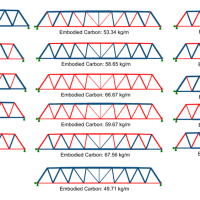Tag: sustainable-structures
-
 Minimizing Embodied Carbon in Multi-Material Structural Optimization of Planar TrussesResearch, 2016 - 2018
Minimizing Embodied Carbon in Multi-Material Structural Optimization of Planar TrussesResearch, 2016 - 2018Material type and quantity are important in determining the embodied carbon emissions for a buildings because both will affect the amount of carbon emitted from the material production. In particular, structural systems such as long-span trusses contribute a substantial amount to a buildings' total embodied carbon, and are the focus on this work. Two common materials for truss structures are timber and steel. While timber’s embodied carbon coefficient and density are lower than that of steel, its much lower strength means that it may not always result in the least carbon emitting structural design. As a result, the choice of the more sustainable material for any given member is dependent on factors such as the truss span or shape. Multi-material structures offer a solution to create structurally efficient structures with lower environmental impact. This embodied carbon optimization investigates truss structures of various spans using parametric modeling and numerical optimization, and studies how multi-material and single-material designs compare. This research introduces a new approach for multi-material designs for the optimization of embodied carbon and demonstrates the advantages of using structural optimization and multi-material designs for sustainability.


